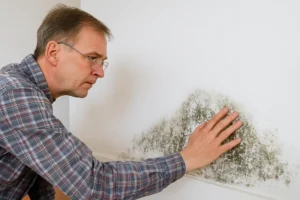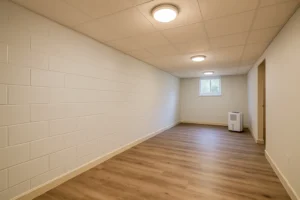Is It Safe to Return Home After a Flood?
Mildew and molds are types of fungi—simple microscopic organisms that thrive in moist environments. While molds play a natural role in breaking down organic materials like fallen leaves and enriching soil, they become destructive and harmful when they invade our homes.
Mold can grow on just about anything organic, including:
- Wood products
- Ceiling tiles
- Cardboard
- Wallpaper
- Carpets
- Drywall
- Fabrics
- Insulation
- Food
How Fast Does Mold Grow After Water Damage?
Within 24 to 48 Hours
Mold growth can begin surprisingly quickly in the right conditions. All it takes is a damp surface and exposure to mold spores, which are always present in the air. Within just 24 hours of water exposure, these tiny spores can attach to porous materials like wood or drywall and start to colonize.
The speed at which mold grows depends on several factors, including the type of mold, the amount of moisture present, and the temperature of the environment. However, the fact that it can begin to grow within a single day highlights the importance of addressing water damage quickly and effectively.
It’s important to note that not all mold growth is visible. In some cases, mold can grow behind walls or under floors, where it can cause structural damage and health problems without being detected. This is why it’s crucial to be vigilant about water damage and to take steps to prevent mold growth before it becomes a problem.
Factors That Accelerate Growth
Mold thrives in environments that provide it with the necessary conditions to flourish.
Environmental Conditions
High Humidity
Mold loves moisture, and a relative humidity level above 40% provides an ideal breeding ground.
Warm Temperatures
Most molds grow best in warm temperatures between 77°F and 86°F (25°C and 30°C).
Poor Ventilation
Stagnant air prevents moisture from escaping, creating a damp environment where mold can thrive.
Organic Material
Mold feeds on organic materials like wood, paper, drywall, and dust.
Flooding
Whether from natural disasters or plumbing issues, flooding introduces a significant amount of moisture into your home, creating a perfect environment for mold growth.
Roof or Plumbing Leaks
Even small leaks can cause water damage and create dampness that fosters mold growth.
Damp Basements or Crawl Spaces
These areas are often prone to moisture problems due to poor drainage, condensation, or groundwater seepage.
Overflow from Sinks or Tubs
Spills and overflows can lead to water damage and mold growth if not cleaned up promptly.
Sewage Backup
Not only is it water intrusion, thus, moisture provider, sewage contains hazardous bacteria and fungi, including mold spores.
High Indoor Humidity
Activities like showering, cooking, and using humidifiers can increase indoor humidity levels, contributing to mold growth.
Why Mold Is Dangerous to Your Home and Health
Home Damage
- Drywall can weaken and crumble
- Flooring and carpet can rot
- Structural wood can be compromised

Health Effects
Respiratory Problems
Mold exposure can irritate the respiratory system, causing sneezing, runny nose, coughing, and wheezing. In individuals with asthma or allergies, mold can trigger asthma attacks, worsen existing respiratory conditions, or lead to the development of chronic bronchitis.
Allergic Reactions
Mold spores are a common allergen, and exposure can cause allergic rhinitis (hay fever), characterized by sneezing, runny nose, itchy eyes, and congestion. Mold allergies can also lead to sinusitis, asthma, and other allergic conditions.
Skin Irritation
Contact with mold can cause skin rashes, itching, and irritation. Some types of mold can also cause more severe skin infections, such as ringworm or athlete's foot.
Neurological Symptoms
In some cases, mold exposure has been linked to neurological symptoms, such as headaches, dizziness, fatigue, and difficulty concentrating. This is particularly associated with exposure to certain types of mold that produce mycotoxins.
Immunological Effects
Mold exposure can affect the immune system, making individuals more susceptible to infections and other health problems.
Infections
While less common, mold exposure can lead to infections in individuals with weakened immune systems. Certain types of mold can cause fungal infections in the lungs, skin, and other organs.
Mold Prevention: What You Can Do Now
Stop the Water Source
- Fix leaks and seal cracks.
- Redirect rainwater and ensure your home’s grading slopes away from the foundation.
- Cover crawlspaces with plastic and ventilate to reduce ground moisture.
Keep It Clean and Dry
- Wash and dry fabrics frequently.
- Use dehumidifiers and fans—but not if mold is already present, as this can spread spores.
- Keep indoor humidity below 40%.
Disinfect Frequently
- Check bathrooms, laundry areas, and mechanical rooms for odors and mold.
- Use a 10% bleach solution (1 1/4 to 1 1/2 cups bleach to a gallon of water) or commercial disinfectants.
Why You Need a Professional Restoration Team
- Industrial-grade drying and dehumidifying equipment
- Moisture detection tools
- Antimicrobial treatments to prevent mold regrowth
- Structural assessments to ensure safety and long-term stability





